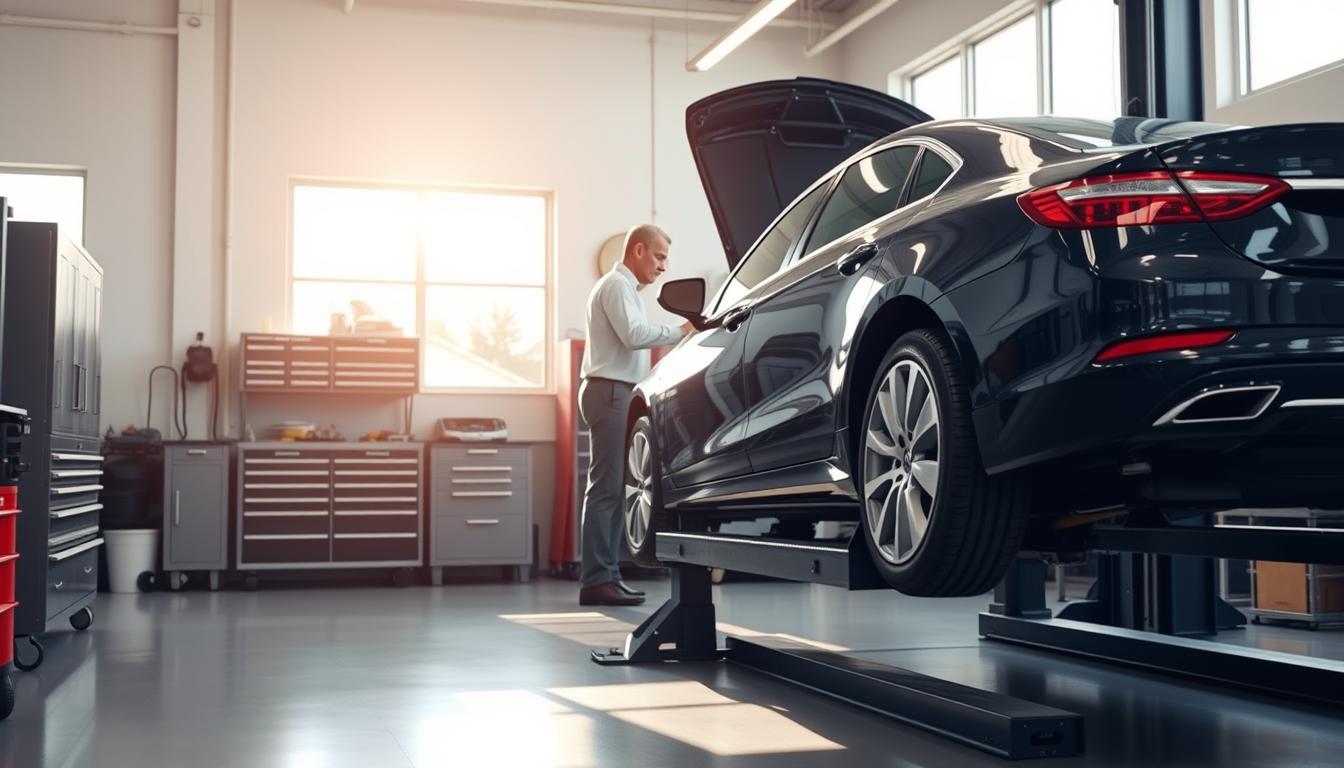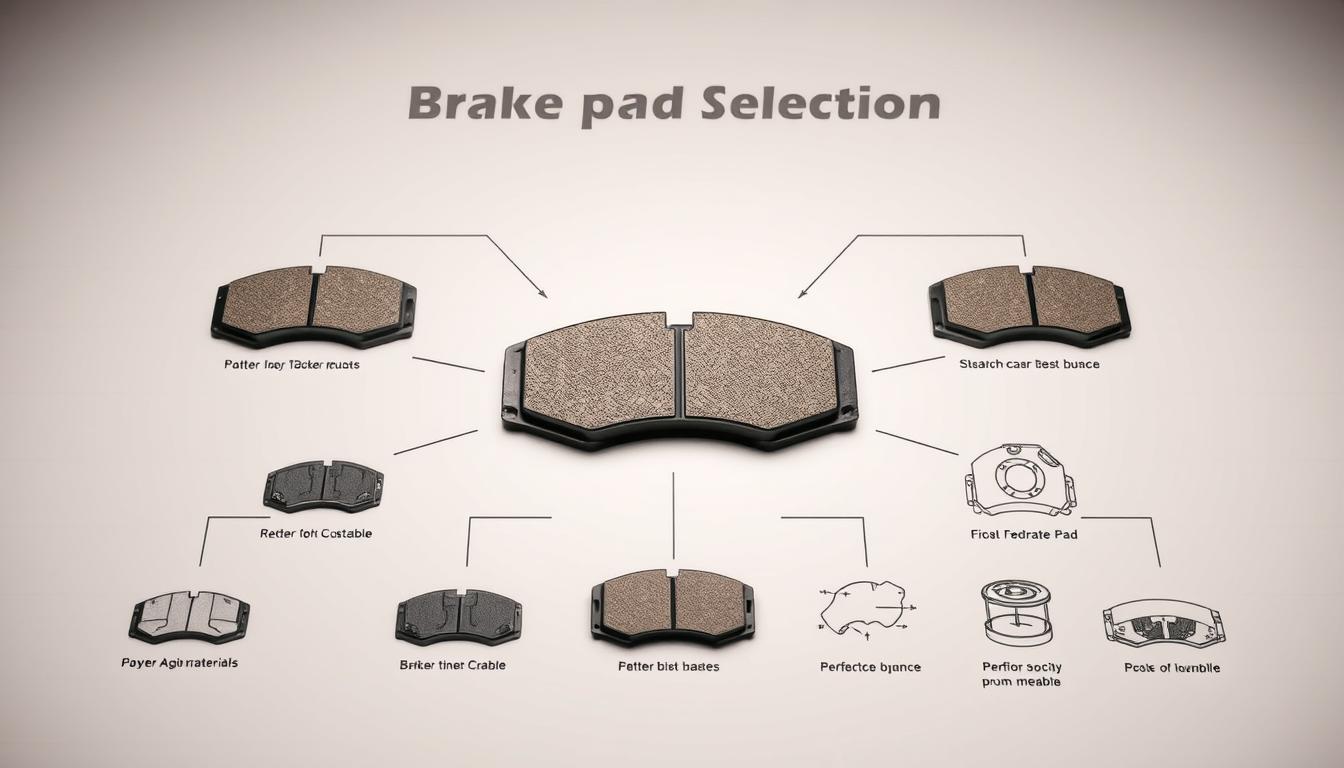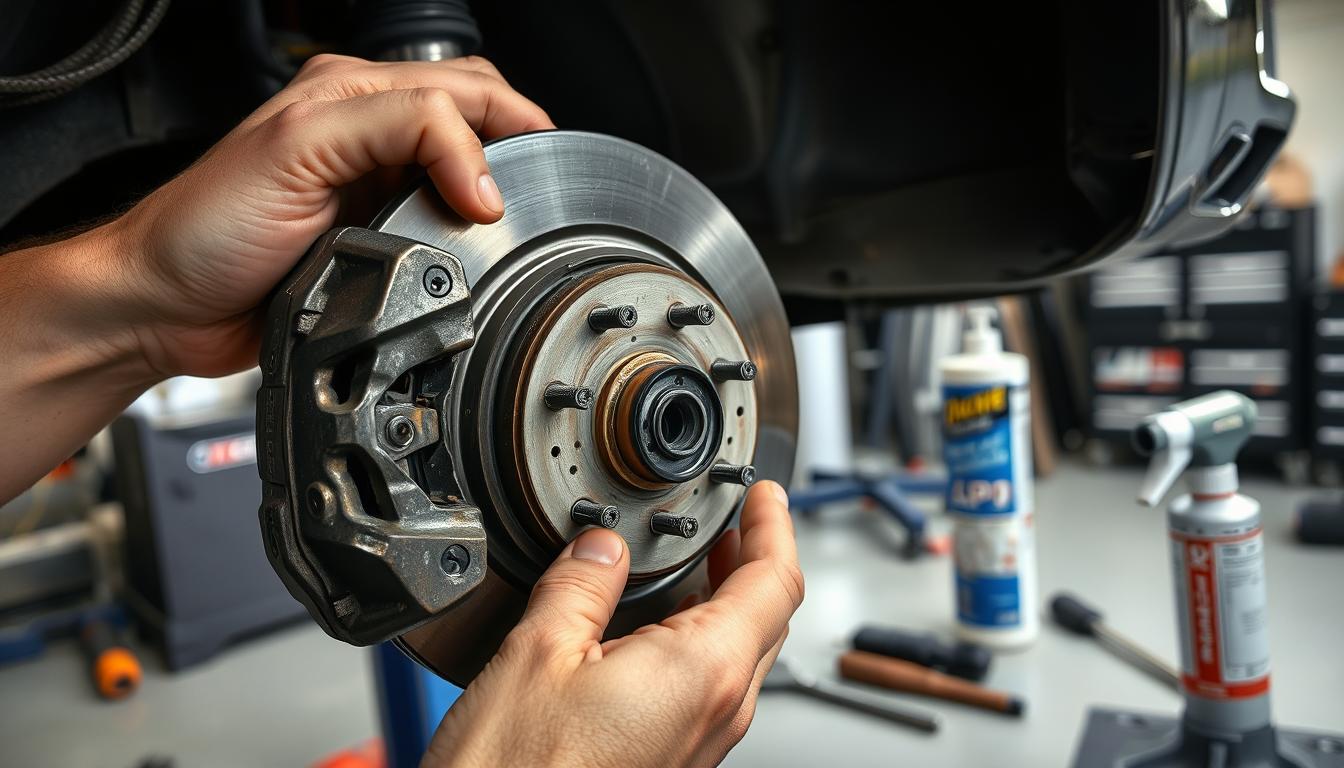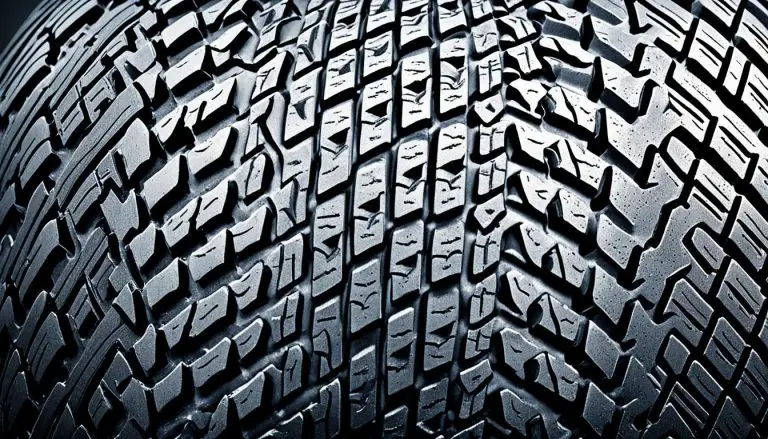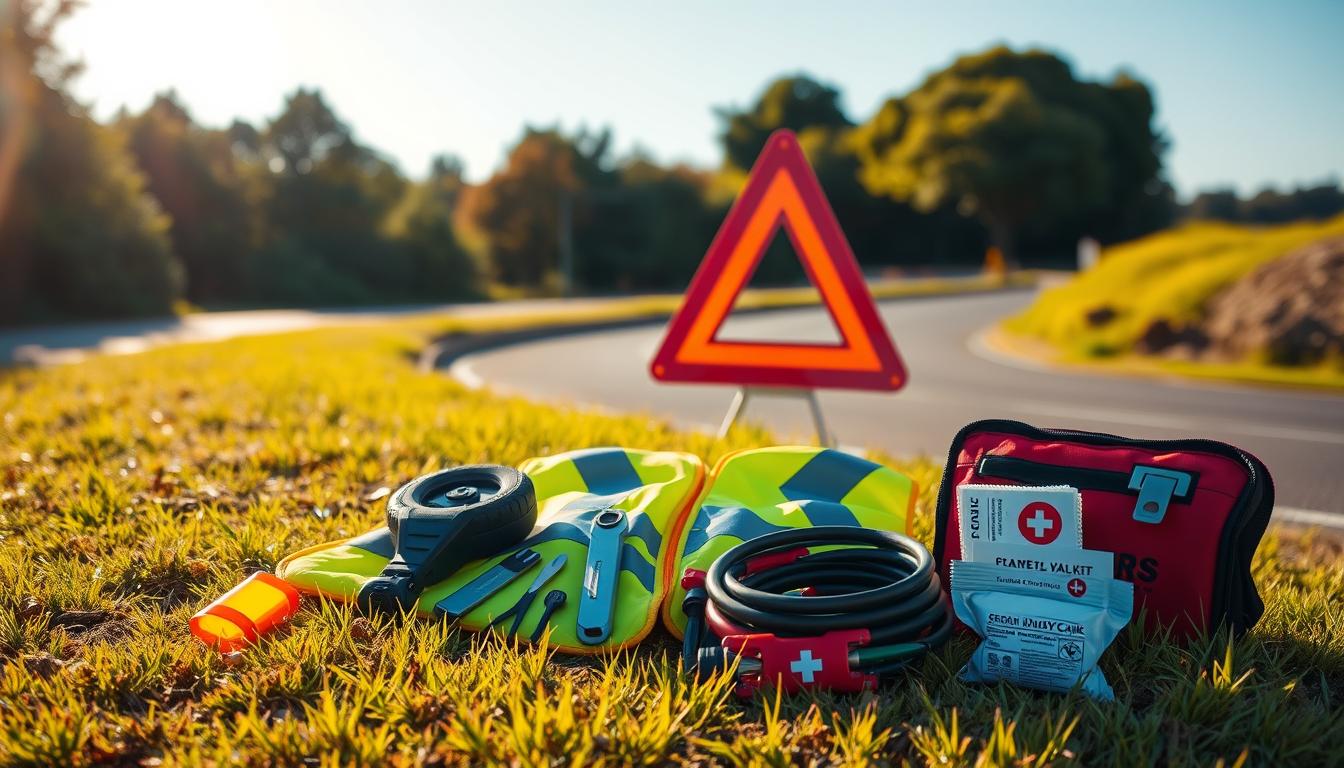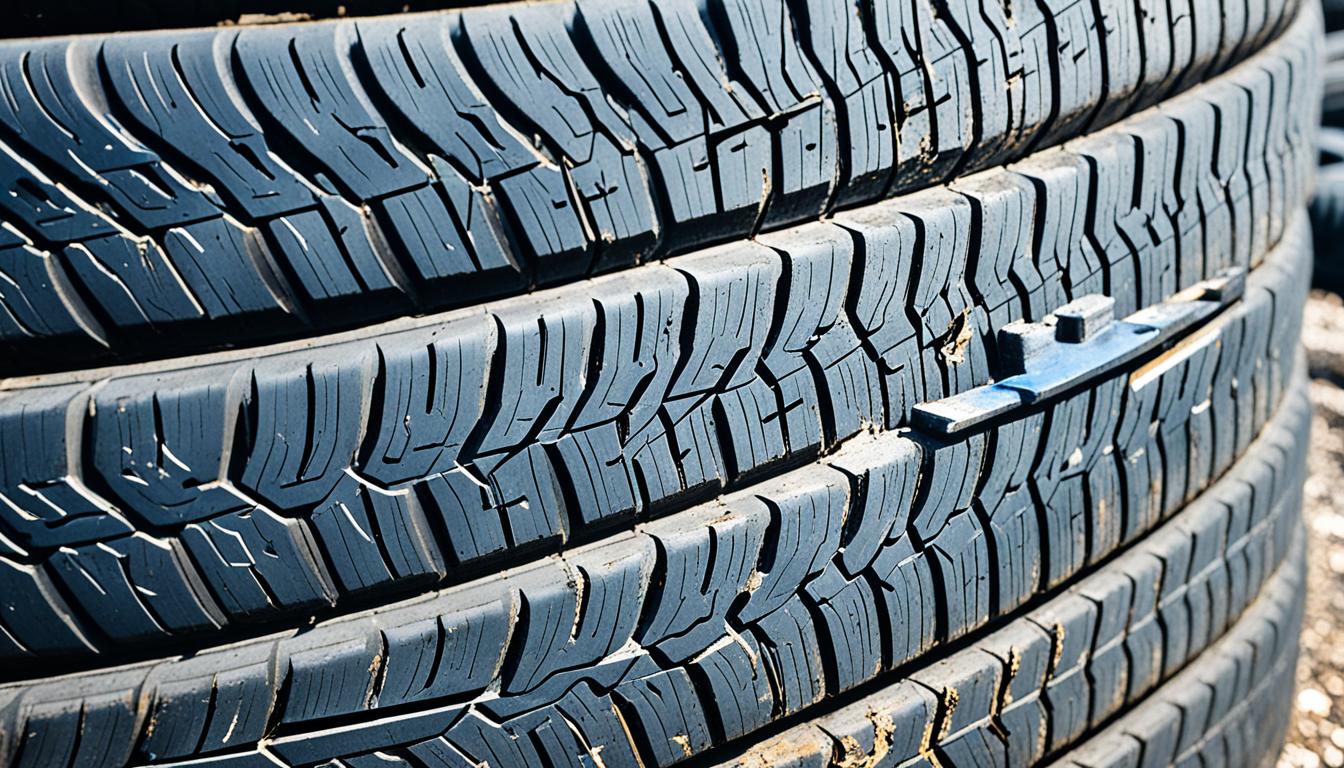
Did you know that a tire’s safety plummets significantly when its tread depth is just 1.6 mm (2/32 of an inch)? This is due to the contact area with the road diminishing to a mere 6% of what it was when new. Therefore, it’s essential to grasp the timing for tire replacements to maintain safety and peak performance of your vehicle.
The timely replacement of tires is crucial for your vehicle’s condition. Key indicators that suggest it’s time for new tires are wear depth, sidewall damage, irregular wear patterns, and how old the tires are. Regular tire inspection and understanding these signs can help you catch the replacement needs before they lead to issues.
Being ahead in replacing tires can enhance your vehicle’s control and safety. In this piece, we will dive into the vital factors for deciding when a tire change is due. This knowledge will guide you in making optimal decisions for both your safety and your vehicle’s durability.
Tire Tread Depth: The Ultimate Indicator
The depth of your tire’s tread is essential for knowing when to change them. In the U.S., tires are legally required to have a minimum depth of 2/32″. By routinely evaluating your tire tread depth, you can spot signs of wear early. This helps ensure your vehicle’s safety by knowing when it’s time for new tires.
Measuring Tread Depth
There are different methods to measure tire tread depth, including special gauges or using a penny. For the penny test, place a penny headfirst into the tread. If the top of Lincoln’s head is visible, the tread is too worn. This indicates it’s time to shop for new tires.
The Penny Test: A Simple DIY Method
The penny test for tire tread is both fast and simple. Insert a penny into the tire’s groove with Lincoln’s head pointing down. If you can see the head, your tires need to be changed. Performing this test regularly is an easy way to keep your tires in good condition. It promotes safe driving by ensuring your tires have enough tread for optimal traction.
Tire maintenance is key to driving safely. By checking your tires often and changing them as needed, you enhance your vehicle’s performance. This effort helps you steer clear of risky road situations.
Sidewall Damage: A Red Flag for Replacement
Aside from checking tread depth, it’s vital to examine your tires’ sidewalls for harm. Signs like bulges, cuts, and cracks can mean the tire’s structure is weak. This endangers its safety. Any of these issues means the tire must be swapped out, no matter its tread depth.
Identifying Bulges, Cuts, and Cracks
Seeing bulges on the sidewall usually signifies the tire’s internal frame is damaged. This lets air into the outer layers, creating a bulge that can burst. Monitor bulges closely for an avoidable tire blowout.
External impacts, like hitting a curb, cause cuts and cracks in the sidewall. These injuries can get worse as the tire flexes during driving, letting air out. This makes them a serious concern too.
Any visible sidewall damage demands immediate action, whether it’s a bulge, cut, or crack. With such damage, using the tire is dangerous for you and others sharing the road.
Regular checks and maintenance are key to catching sidewall damage early. With constant vigilance and a quick response to damages, your car’s performance and safety stay top-notch.
Uneven Wear: A Sign of Alignment Issues
Uneven tire wear can point to bigger problems like misalignment or incorrect inflation. If a tire’s tread wears out in just one spot, you might need your alignment fixed. Issues with suspension or other parts could also be at play.
Fixing the cause of uneven wear is vital for tire health and a smooth, safe drive. Experts advise aligning your tires every 6,000 miles or with every other oil change. Although careful driving helps, some misalignment is bound to happen over time.
Alignment troubles often trace back to events like hitting curbs, potholes, or accidents. These can lead to various symptoms, such as:
- Camber wear, showing the inside or outside is worn more, hinting at camber issues.
- Heel/toe wear, meaning one side wears faster in a circular pattern.
- Feathering of tires, where one side is smooth and the other is sharp, often from toe misalignment.
The way tread wears is a primary indicator of poor alignment’s effects on driving. Signs include noisy, vibrational turns, pulling, or a crooked steering wheel. Also, note worsening handling, especially when braking or turning.
If your alignment is off, setting up a check at a reliable shop is wise. Make alignment checks part of your car’s regular care to keep it running well. After accidents, potholes, or rough bumps, don’t wait, get your alignment looked at sooner.
| Alignment Issue | Symptoms |
|---|---|
| Camber Wear | Inside or outside of treads more worn than center |
| Heel/Toe Wear | One side of treads worn out more rapidly than the other |
| Feathering | One side smooth, other side sharp |
Dealing with uneven wear early not only saves your tires but also makes driving safer and smoother. Stay on top of maintenance and alignment for optimal vehicle performance. This care helps keep your family safe and sound on every journey.
tire replacement criteria
Deciding when to change your tires is critical for your car’s upkeep. It involves examining the tread depth, looking for sidewall damage, and checking for uneven wear or the tire’s age. Making sure your tires are in top condition is crucial for your safety, your passengers’, and other commuters.
Tread Depth: The Minimum Requirement
Tires are legally safe when their tread depth is 2/32″ or more. This is confirmed through the “penny test.” Simply insert a penny into a tread groove with Lincoln’s head facing down. If you see the top of his head, it’s time to get a new tire.
Sidewall Damage: A Clear Indicator
External harm to a tire’s sidewall, like bulges, cuts, or cracks, is a red flag. Such damage can weaken the tire’s structure and up the chances of a blowout or other serious problems.
Uneven Wear: Addressing Alignment Issues
Irregular wear on a tire may signal alignment issues or mechanical faults. Ignoring these signs could hasten the tire’s wear and compel an earlier replacement.
Tire Age: Industry Standards
The recommendation is to swap passenger or truck/SUV tires around the six-year point, not later than ten years. This guideline is applicable even if a tire hasn’t been on the road much. Tires degrade with time due to the elements and storage conditions.
| Tire Type | Recommended Replacement Age |
|---|---|
| Passenger Tires | 6 years on average |
| Truck/SUV Tires | 6 years on average |
Being well-versed in tire replacement criteria is key to ensuring a safe and smooth drive. Regular checks and replacements keep your vehicle in top shape and guarantee your safety on the road.
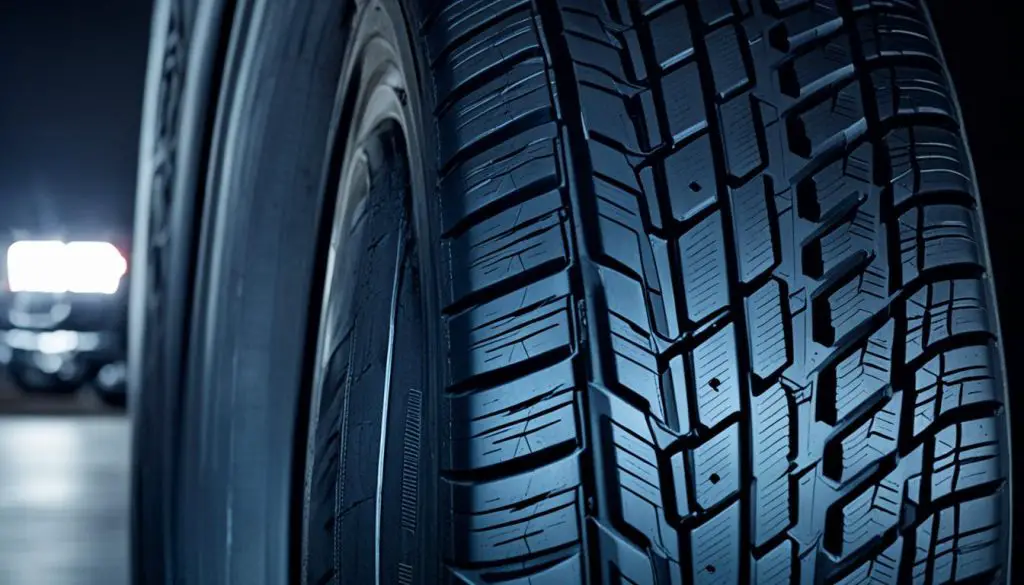
Age Matters: When Tires Should Retire
Tire age is crucial, determined when they need replacing, not just by tread depth. Rubber and tire parts degrade over time, reducing their safety and function. Passenger and truck/SUV tires are recommended for replacement at six years, older than ten years, even if they look fine. The aging problem affects all tires, regardless of use, leading to more chances of failure.
Research by Safety Research & Strategies Inc. shows that in 2012, more than 250 incidents had tires over six years with tread and belt separation. This issue caused 233 deaths and 300 injuries. Tire aging is influenced by heat, storage, underinflation, and how they’re driven.
Understanding Tire Aging
Some carmakers say tires should be swapped six years from their make date, no matter their wear. Tires with longer life are made with chemicals that resist aging. Tire aging speeds up in hot climates, and elements like sunlight and salt from the sea can quicken it, as the NHTSA found.
The 6-Year and 10-Year Rules
Expanding on this, any tire over ten years, including spares, should be replaced. You can check a tire’s make date on its sidewall’s last four digits. The first two show the week, the last two the year.
To make tires last, keep them at the right pressure and aligned. This effort can prolong tire life. But following the car maker’s advice on when to swap them out, based on your car’s use, is key.
Vibrations and Noises: Warnings from Your Tires
Your tires are like ambassadors, conveying vital messages about their health. Unusual vibrations or noises act as early alerts for tire issues. These could include a persistent shake in the steering wheel or a change in the tire’s usual sound.
Moving past these indicators without attention can birth severe problems. This negligence might cause not only uneven wear but also other significant concerns.
Sudden vibrations or odd sounds demand quick action. Swift response could pin down the cause, be it a need for new tires or crucial maintenance. In the U.S., over 11,000 crashes each year tie back to tire woes. This underlines the critical role of proactive tire care for road safety.
Identifying Vibrations and Noises
Messages from your tires often start subtly but can progress quickly. Vibrations might transmit through the steering wheel or the whole vehicle, joined by unusual sounds. These sounds – humming, whirring, or rumbling – convey your tires’ tales.
Such symptoms might trace back to several issues:
- Uneven Wear: Unsmooth wear patterns on tires create noise and vibration, hinting at troubles within.
- Imbalanced Tires: Poorly balanced tires shake most at certain speeds, signaling intervention is needed.
- Misaligned Suspension: Problems in the suspension, from misalignment to worn parts, can sound an alarm through your tires.
Don’t overlook these signs. Always get a professional’s opinion. They should inspect your tires and vehicle to diagnose the root issue. Proper early diagnosis can prevent major crises.
Maintaining Tire Condition
Watching for vibrations and sounds and checking tread depth can stave off tire calamities. Measure your tread monthly and rotate tires every 5,000 to 8,000 miles to even out the damage. Correct tire pressure is key, preventing premature aging and reducing vibrations.
Being proactive protects not just your tires but your safety too. It keeps your vehicle’s road connection secure. Don’t disregard these tire wakes; staying on top of tire care keeps you safe and on the go.

Choosing the Right Replacement Tires
Tire Categories: All-Season, Performance, and More
When it’s time to replace your tires, making the right choice is vital. It affects your car’s performance, keeps you safe, and saves fuel. Tires are grouped into categories, each serving different driving needs and environments.
All-season tires are a top choice for their year-round versatility. They offer decent traction in dry, wet, and light snowy conditions. While they’re perfect for daily driving, they’re not the best for harsh winter weather, unlike winter tires.
If you enjoy sporty driving and need high speeds, performance tires might be what you want. They provide top-notch grip and quick steering responses. But, they can be less comfortable on rough roads and wear out faster than other types.
In areas with lots of snow or ice, winter tires stand out. With special designs and materials, they give the best traction in cold weather. They beat all-season or regular summer tires for winter driving.
Picking the right tires means looking at your car’s type, how you drive, where you live, and what you like. If you’re unsure, talking to a tire expert is a smart move. They can guide you to the perfect tire features for your specific situation.
Getting the perfect replacement tires is key for your car’s performance and safety. Knowing about the different tire types and their strengths helps you choose wisely. This way, your driving experience matches your needs and the weather you face.
Tire Maintenance: Extending Tread Life
Proper tire maintenance is key to extending tire life and maintaining peak performance. Tire inflation and tire rotation are critical.
Proper Inflation and Rotation
Keeping your tires at the correct pressure is essential. Low tire pressure can quicken the wear, lower gas mileage, and impact how your vehicle handles. After September 2007, all new vehicles must include a Tire Pressure Monitoring System (TPMS), which helps monitor tire pressure.
Regular tire rotation, typically every 6,000 to 8,000 miles, is also important. It ensures even tire wear, extending the tread life. A mechanic should balance the tires after rotation. This ensures a smooth, safe drive.
| Tire Treadwear Ratings | Percentage of Current Tires |
|---|---|
| Below 200 | 15% |
| 201 – 300 | 25% |
| 301 – 400 | 32% |
| 401 – 500 | 20% |
| 501 – 600 | 6% |
| Above 600 | 2% |
By consistently checking tire pressure and rotating them, you can prolong tire life. This simple upkeep decreases costs over time. It also promotes better vehicle safety and performance.
The Risks of Used Tires
Choosing used tires might seem like a wise money-saving option. However, it carries serious risks. Used tires can threaten your safety and your car’s handling. Knowing these risks is key to a smart choice.
The main issue with used tires is their unknown past. You might not learn how the tire was used before. Was it properly inflated? Did it suffer hidden damage? Such tires, if badly worn out or damaged in the past, might fail to offer the needed traction and grip on the road.
Figuring out a used tire’s true age is also not easy. Tire age matters greatly because as tires grow older, their materials can weaken. This can make them less safe and less reliable. Tire safety experts often suggest swapping tires every 6 to 10 years, no matter the tread depth, to ensure safety.
The National Highway Traffic Safety Administration notes that tire accidents are a major cause of traffic deaths. Choosing new tires that fit your car according to the manufacturer’s recommendations can boost safety for you, those with you, and others on the road.
While used tires can seem like a good way to save now, their dangers might cost more in the long run. For your safety and that of your family, using new tires with a clear history and the right standards is usually the best decision.
Conclusion
Replacing your vehicle’s tires is paramount, often overlooked. Understanding crucial criteria like tire replacement tread depth, sidewall damage, and age ensures road safety. Regular checks, maintenance, and timely replacements extend tire life, curbing surprises and accidents.
Your tires serve as the sole link between your vehicle and the road. So, investing in top-notch replacements and monitoring their state is critical. Learn and follow recommended guidelines and tire safety tips. This knowledge aids informed decisions, keeping your vehicle running smoothly.
By focusing on tire care and timely swap-outs, you improve your tires’ lifespan. Moreover, this habit makes the road safer for everyone. Make checking your tires a routine. Swiftly swap them out when needed for your safety and peace of mind when driving.
FAQ
Q: What are the key criteria for determining when to replace tires?
A: Tread depth, sidewall damage, uneven wear, and tire age are vital in deciding when to replace tires. Assessing these factors helps maintain vehicle safety.
Q: How do I measure tread depth?
A: To measure tread depth, use a tread gauge or perform the penny test. In the penny test, if you see the top of Lincoln’s head, your tire is at 2/32″ and needs replacing.
Q: What are signs of sidewall damage that require tire replacement?
A: Identifying bulges, cuts, and cracks on a tire’s sidewall is crucial. These signs show structural problems, meaning the tire is no longer safe to use.
Q: What causes uneven tire wear, and how does it affect when to replace tires?
A: Uneven tire wear points to potential alignment issues or other problems. Resolving these can prevent further damage and ensure safety on the road.
Q: How does tire age factor into the replacement decision?
A: The age of tires plays a significant role in replacement decisions. Experts suggest replacing tires between six and ten years to avoid performance and safety risks due to aging.
Q: What other signs indicate it’s time to replace my tires?
A: Aside from visible wear, be alert to vibrations and unusual tire noises. These issues may signal both wear problems and broader maintenance needs.
Q: How do I choose the right replacement tires for my vehicle?
A: Choosing the right tires involves considering your vehicle’s specifications, driving habits, and local weather conditions. A tire professional can offer tailored guidance.
Q: How can I extend the life of my tires?
A: Regular tire maintenance, like checking inflation and rotating tires, enhances their durability. This upkeep minimizes wear and tear, thereby extending tread life.
Q: Are used tires a good option for replacement?
A: Used tires pose safety and performance risks. The uncertainty of their history, condition, and potential damage makes new, manufacturer-recommended tires the preferred choice for replacement.
